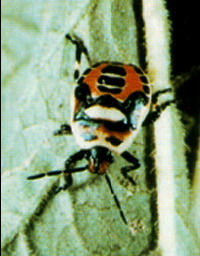Two-spotted Stink Bug (Perillus bioculatus) {!--노린재류--> Modified from G. Bishop, et al. 1982. Management of Potato Insects in the Western States. WREP Pub. 64.
TWO SPOTTED STINK BUG Hemiptera: Pentatomidae Perillus bioculatus
___________________________________________________________________________
DESCRIPTION
Mature nymphs of the two spotted stink bug are about 8 to 9 mm long. Adults range in length from 10 to 12 mm. Nymphs may pale yellow or reddishorange with a distinct black "Y-shaped" marking on the pronotum and two black spots on the thorax.
LIFE HISTORY
Adults overwinter under plant debris or in the soil around the margins of potato fields or other uncultivated areas. Some adults may fly to more suitable overwintering sites, such as in buildings. Adults begin emerging in late May and June and begin laying eggs in about 7 days. Eggs are laid in June and July in a compact double row containing 18 to 25 eggs on the upper surface of potato leaves. Eggs hatch in 5 to 8 days and first instars begin sucking plant juices from potato stems. Development of all instars requires about 18 to 20 days at 24°C. In the summer, the average time for development from egg to adult requires about 25 to 30 days. Adults enter the overwintering stage in September or October. Under favorable conditions, the adults that mature in August and September of one year may be expected to overwinter and live until early June of the following year.
IMPORTANCE
This predator occurs throughout the Northwest and is a predator of the Colorado potato beetle. Occasionally this predator may provide control of the Colorado potato beetle, but it rarely occurs in large enough numbers to provide adequate control. Studies have shown that nymphs consume an average of 285 Colorado potato beetle eggs, 3.7 larvae, and 5.1 adults during development of instars 1-5. Others have shown that instars 4 and 5 consume up to 59 Colorado potato beetle eggs per day at 24°C. Adults may eat up to 85 Colorado potato beetle larvae during a 6 week period. First instars feed exclusively on potato plant juices and older nymphs and adults feed on plant juices from time to time. It would require an average of 1.5 P. bioculatus per plant to reduce the Colorado potato beetle population to zero in seven days, which is still much higher than populations of predators found in potato fields (typically < 0.5 predators/plant). However, 100% mortality of Colorado potato beetle is unnecessary to avoid economic damage.
Photo: Two spotted stink bug nymph
Source: PNWPEST.ORG http://pnwpest.org/
